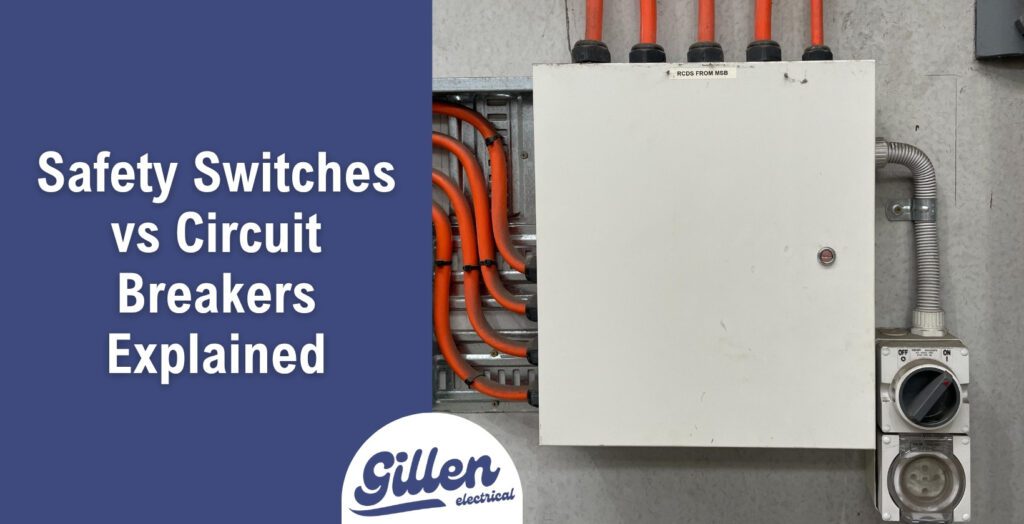A safety switch, also called a residual current device (RCD), is not the same as a circuit breaker. Understanding the difference is essential for keeping your home, business, and electrical systems safe. Every switchboard should include both devices, yet many people confuse their roles.
A commercial electrician will install, test, or upgrade these devices to meet the latest standards and improve system protection. Safety switches protect people from electrocution, while circuit breakers stop fires caused by overloaded wiring.
In this blog, we’ll explain what a safety switch and circuit breaker do, why both are required, how they’re used in switchboards, and when to test them.
What Is A Safety Switch (RCD)?
A safety switch, or RCD, detects leakage current and shuts the power off before electrocution occurs. It constantly monitors live and neutral current for any imbalance.
RCDs are required on every new residential circuit and should be installed wherever there’s risk of water, contact, or faulty equipment. This includes circuits for power points, lighting, ovens, and air conditioners.
Homes in flood-prone areas benefit even more from RCD protection. In fact, storm and flood electrical safety guidelines recommend RCDs as a primary defence for household circuits.
Legal Residential Requirement
Australian wiring rules (AS/NZS 3000) require RCDs on all final sub-circuits in new homes. This applies to lighting, socket outlets, and appliances.
Older homes built before these regulations may have no safety switches at all. Upgrading these boards is strongly recommended for safety and insurance compliance.
RCDs In Switchboards
RCDs are usually installed on each individual circuit within the switchboard. This allows one fault to isolate safely without shutting off the entire board.
Each RCD monitors the difference in current between active and neutral conductors. If that current leaks to earth — such as through a human — the RCD trips within 30 milliseconds.
What Is A Circuit Breaker?
Circuit breakers protect wiring, not people. They trip when electrical flow exceeds the cable’s safe limit or a short circuit occurs.
Unlike RCDs, they don’t detect current leakage. Their role is to prevent overheating, arcing, and fires caused by excess current.
How Circuit Breakers Detect Faults
Circuit breakers measure the amount of current flowing through a circuit. When that current exceeds its rating, the breaker trips.
This protects the cable and connected appliances from heat damage. It does not prevent electrocution if someone touches live wires.
Types Of Circuit Breakers: Single‑Phase Vs Double‑Pole
Single-phase circuit breakers are used on general lighting and power circuits. They handle 240 V loads like GPOs and lights.
Double-pole circuit breakers are designed for higher-demand appliances such as cooktops, air conditioners, and electric hot water units. These protect both active and neutral lines simultaneously.
Is A Safety Switch And An RCD The Same Thing?
Yes — a “safety switch” is the everyday name, and “RCD” is the technical term. Both refer to the exact same device.
Government regulations, wiring rules, and electrical retailers often use “RCD,” while consumer material prefers “safety switch.” Search engines show people use both terms interchangeably, so it’s important to reference both.
Key Differences Between Safety Switches (RCDs) And Circuit Breakers
Here are the main differences between safety switches and circuit breakers:
| Situation | RCD | Circuit Breaker |
|---|---|---|
| When do they trip? | RCDs trip when current leaks to earth | Circuit breakers trip when too much current flows through a circuit |
| How fast do they trip? | RCDs respond to faults within 30 milliseconds | Circuit breakers trip in milliseconds to seconds depending on the fault type and breaker rating |
| What do they protect? | RCDs protect people from electrocution | Circuit breakers protect cables, switchboards, and appliances from overheating |
When To Use Both Device
Every home and business should have both RCDs and circuit breakers. They work together to provide complete circuit protection.
Some switchboards combine both into a single device called an RCBO, but others use them separately depending on layout, load types, and compliance requirements.
Combined RCD/Circuit Breaker Units
Combination units are called RCBOs or Residual Current Breaker with Overcurrent protection. These do the job of both a circuit breaker and a safety switch.
They’re ideal when space is limited or when separate RCDs and breakers aren’t practical. Many modern boards now use only RCBOs across all circuits.
Why You Should Test RCDs Regularly
RCDs must be tested every 3 months using the test button marked “T” or “Test.” This simulates a fault and checks that the RCD trips correctly.
If it fails to trip, the switch no longer protects you. It must be replaced immediately by a licensed electrician.
Routine testing ensures your RCD will work during an emergency. It takes seconds to check and could save a life.

